2" Anthurium clarinervium
Care
 Medium to bright indirect light
Medium to bright indirect light
 Allow soil to dry halfway before watering
Allow soil to dry halfway before watering
 Loves humidity
Loves humidity
Anthurium clarinervium is a popular plant, mostly sought after for its unique foliage. The leaves on this particular species are thick and have an almost cardboard type texture. The prominent veins are bright white and very eye catching.
Anthurium clarinervium is endemic to Chiapas, Mexico. In it's natural habitat they're found growing on rocky outcroppings so as an indoor plant they are much more tolerant of a wide range of conditions.
Anthurium clarinervium care:
Allow the soil to dry out almost completely between watering. Anthurium prefer medium indirect light to maintain their dark green color, but will do just fine in bright indirect light.
Additional info:
Anthurium is a large genus of ornamental, mostly epiphytic plants. Some species of Anthurium do have a terrestrial growth habit.
Anthurium are native to tropical areas of Latin America. They grow in a wide variety of climates, ranging from lowland to higher elevations. Certain species need high humidity, while others will grow just fine in ambient household humidity.
Their foliage varies greatly, with some having thick corrugated textures and others with velvety textures.
Anthurium prefer a well draining soil, rich in organic matter.
They are prized for their ease of care and their sometimes showy, colorful flowers.
Anthurium can thrive in lower light but grow faster in brighter indirect light.





